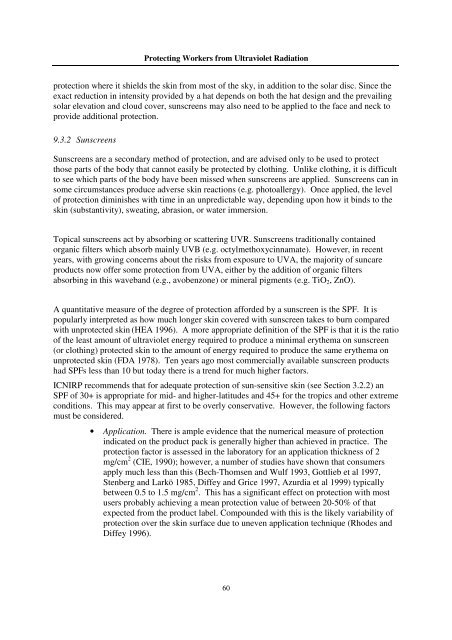Protecting Workers from Ultraviolet Radiation - icnirp
Protecting Workers from Ultraviolet Radiation - icnirp
Protecting Workers from Ultraviolet Radiation - icnirp
You also want an ePaper? Increase the reach of your titles
YUMPU automatically turns print PDFs into web optimized ePapers that Google loves.
<strong>Protecting</strong> <strong>Workers</strong> <strong>from</strong> <strong>Ultraviolet</strong> <strong>Radiation</strong><br />
protection where it shields the skin <strong>from</strong> most of the sky, in addition to the solar disc. Since the<br />
exact reduction in intensity provided by a hat depends on both the hat design and the prevailing<br />
solar elevation and cloud cover, sunscreens may also need to be applied to the face and neck to<br />
provide additional protection.<br />
9.3.2 Sunscreens<br />
Sunscreens are a secondary method of protection, and are advised only to be used to protect<br />
those parts of the body that cannot easily be protected by clothing. Unlike clothing, it is difficult<br />
to see which parts of the body have been missed when sunscreens are applied. Sunscreens can in<br />
some circumstances produce adverse skin reactions (e.g. photoallergy). Once applied, the level<br />
of protection diminishes with time in an unpredictable way, depending upon how it binds to the<br />
skin (substantivity), sweating, abrasion, or water immersion.<br />
Topical sunscreens act by absorbing or scattering UVR. Sunscreens traditionally contained<br />
organic filters which absorb mainly UVB (e.g. octylmethoxycinnamate). However, in recent<br />
years, with growing concerns about the risks <strong>from</strong> exposure to UVA, the majority of suncare<br />
products now offer some protection <strong>from</strong> UVA, either by the addition of organic filters<br />
absorbing in this waveband (e.g., avobenzone) or mineral pigments (e.g. TiO2, ZnO).<br />
A quantitative measure of the degree of protection afforded by a sunscreen is the SPF. It is<br />
popularly interpreted as how much longer skin covered with sunscreen takes to burn compared<br />
with unprotected skin (HEA 1996). A more appropriate definition of the SPF is that it is the ratio<br />
of the least amount of ultraviolet energy required to produce a minimal erythema on sunscreen<br />
(or clothing) protected skin to the amount of energy required to produce the same erythema on<br />
unprotected skin (FDA 1978). Ten years ago most commercially available sunscreen products<br />
had SPFs less than 10 but today there is a trend for much higher factors.<br />
ICNIRP recommends that for adequate protection of sun-sensitive skin (see Section 3.2.2) an<br />
SPF of 30+ is appropriate for mid- and higher-latitudes and 45+ for the tropics and other extreme<br />
conditions. This may appear at first to be overly conservative. However, the following factors<br />
must be considered.<br />
• Application. There is ample evidence that the numerical measure of protection<br />
indicated on the product pack is generally higher than achieved in practice. The<br />
protection factor is assessed in the laboratory for an application thickness of 2<br />
mg/cm 2 (CIE, 1990); however, a number of studies have shown that consumers<br />
apply much less than this (Bech-Thomsen and Wulf 1993, Gottlieb et al 1997,<br />
Stenberg and Larkö 1985, Diffey and Grice 1997, Azurdia et al 1999) typically<br />
between 0.5 to 1.5 mg/cm 2 . This has a significant effect on protection with most<br />
users probably achieving a mean protection value of between 20-50% of that<br />
expected <strong>from</strong> the product label. Compounded with this is the likely variability of<br />
protection over the skin surface due to uneven application technique (Rhodes and<br />
Diffey 1996).<br />
60



